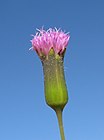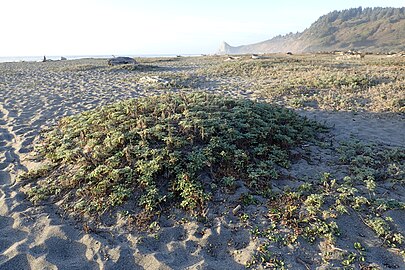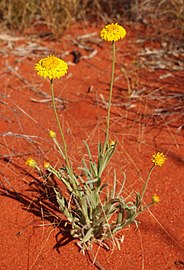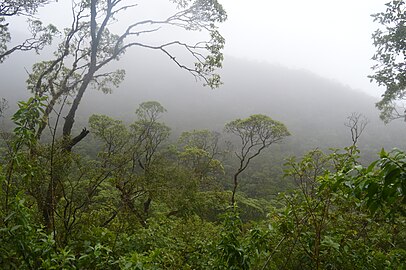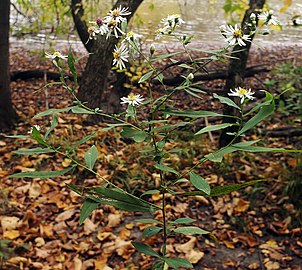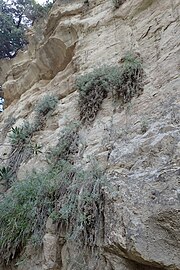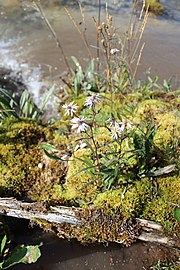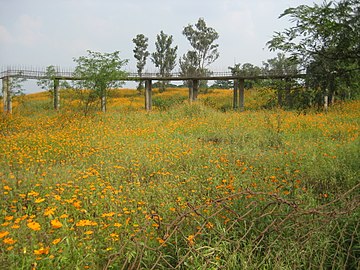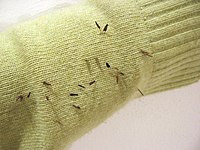| This is a Wikipedia user page. This is not an encyclopedia article or the talk page for an encyclopedia article. |
| Eewilson/sandbox | |
|---|---|
Asteraceae left–right, top–bottom:
Symphyotrichum ericoides,
Acourtia microcephala,
Emilia sonchifolia, and
Helianthus annuus. | |
|
Scientific classification
| |
| Kingdom: | Plantae |
| Clade: | Tracheophytes |
| Clade: | Angiosperms |
| Clade: | Eudicots |
| Clade: | Asterids |
| Order: | Asterales |
| Family: |
Asteraceae Bercht. & J.Presl [2] |
| Type genus | |
|
Aster | |
| Subfamilies[ citation needed] | |
| |
| Diversity [3] | |
| 1,911 genera | |
| Synonyms [4] | |
| |
The family Asteraceae /æstəˈreɪʃiː/, alternatively Compositae /kəmˈpɒzɪtiː/, consists of over 32,000 accepted species of flowering plants in over 1,900 genera within the order Asterales. Commonly referred to as the aster, daisy, composite, or sunflower family, Compositae were first described in 1740. The number of species in Asteraceae is rivaled only by the Orchid family ( Orchidaceae), and which is larger is unclear as the quantity of extant species in each family is unknown.
Most species of Asteraceae are annual, biennial, or perennial herbaceous plants, but there are some shrubs, vines, and trees. The family has a widespread distribution, from subpolar to tropical regions, in a wide variety of habitats. Most occur in hot desert and cold or hot semi-desert climates, and they are found on every continent but Antarctica. A distinguishing characteristic in the family Asteraceae is the existence of sometimes hundreds of tiny individual florets which are held together by protective involucres in flower heads, or more technically, capitula.
The oldest known fossils are pollen grains from the Late Cretaceous ( Campanian to Maastrichtian) of Antarctica, dated to c. 76–66 million years (myr). It is estimated that the crown group of Asteraceae evolved at least 85.9 myr (Late Cretaceous, Santonian) with a stem node age of 88–89 myr (Late Cretaceous, Coniacian).
Asteraceae is an economically important family, providing food staples, garden plants, and herbal medicines. Species outside of their native ranges can be considered weedy or invasive.
Description
Most species of Asteraceae are annual, biennial, or perennial herbaceous plants, but some shrubs, vines, and trees do exist. Asteraceae species are generally easy to distinguish from other plants. However, determining genera and species of some groups such as Hieracium is notoriously difficult (see " damned yellow composite" for example).[ citation needed]
The following six characteristics are always present in Asteraceae species and can be used to distinguish them from other families: [5]
- capitulum of florets with phyllaries in involucres
- fused corolla
- style with two lobes at the apex (usually, but not always, divided)
- five anthers fused into a cylinder (around the style) which then splits upward ( dehisces antrorsely)
- Pappus of capillary setae or of scales (although sometimes absent)
- fruit (seed) a cypsela (sometimes inaccurately called an achene)
Roots
Members of the family Asteraceae generally produce taproots, but sometimes they possess fibrous root systems. Some species have underground stems in the form of caudices or rhizomes. These can be fleshy or woody depending on the species. [6]
Stems
Stems are herbaceous, aerial, branched, and cylindrical with glandular hairs, generally erect, but can be prostrate to ascending. The stems can contain secretory canals with resin [6] or latex which is particularly common within subfamily Cichorioideae. [7]
Leaves
In Asteraceae species, leaves can be alternate, opposite, or whorled. They may be simple, but are often deeply lobed or otherwise incised, often folded upward ( conduplicate) or rolled under ( revolute). The edges (margins) also can be smooth ( entire) or toothed. [6] Resin [6] or latex [7] also can be present in the leaves.
Inflorescences
- a capitulum of florets with phyllaries in involucres
- fused corolla
- a style with two lobes at the apex usually, but not always, divided
- five anthers fused into a cylinder around the style which then splits upward
- Pappus of capillary setae or of scales (although sometimes absent)
- fruit (seed) a cypsela (sometimes inaccurately called an achene)
Asteraceae bear their flowers, called florets, in dense flower heads called capitula (singular, capitulum), which are Asteraceae-specific pseudanthia. The florets inside the capitulum are surrounded on the outside by phyllaries (also called involucral bracts), which can look like scales. Collectively, the phyllaries form an involucre that protects the florets in the capitulum. [8]: 29 When viewed from a distance, each capitulum may appear to be a single flower. Enlarged outer (peripheral) flowers in the capitulum may resemble petals, and the involucral bracts may look like a calyx.
Involucres
.....

Phyllaries
.....
Florets
In Asteraceae species, florets are
.....
Cypselae


In members of the Asteraceae the fruit is achene-like and called a cypsela (plural cypselae). Although there are two fused carpels, there is only one locule, and only one seed per fruit is formed. It may sometimes be winged or spiny because the pappus, which is derived from calyx tissue, often remains on the fruit (for example in dandelion). In some species, however, the pappus falls off (for example in Helianthus). Cypsela morphology is often used to help determine plant relationships at the genus and species level. [9] The mature seeds usually have little endosperm or none. [10]
Pollen
The pollen of some composites is echinolophate (or fenestrate), morphological terms meaning "with elaborate systems of ridges and spines dispersed around and between the apertures." [11]: 486

Floral formula and diagram


Genome
.....
Phytochemistry
In Asteraceae, the energy store is generally in the form of inulin rather than starch. They produce iso/ chlorogenic acid, sesquiterpene lactones, pentacyclic triterpene alcohols, various alkaloids, acetylenes (cyclic, aromatic, with vinyl end groups), tannins. They have terpenoid essential oils which never contain iridoids. [12]
Asteraceae produce secondary metabolites, such as flavonoids and terpenoids. Some of these molecules can inhibit protozoan parasites such as Plasmodium, Trypanosoma, Leishmania and parasitic intestinal worms, and thus have potential in medicine. [13]
Taxonomy
History
Compositae, the original name for Asteraceae, were first described in 1740 by Dutch botanist Adriaan van Royen. [14]: 117–118 Traditionally, two subfamilies were recognised: Asteroideae (or Tubuliflorae) and Cichorioideae (or Liguliflorae).[ citation needed] The latter has been shown to be extensively paraphyletic, and has now been divided into 12 subfamilies, but the former still stands. [15][ needs update] The study of this family is known as synantherology.
Phylogeny
The phylogenetic tree presented below is based on Panero & Funk (2002) [15] updated in 2014, [16] and now also includes the monotypic Famatinanthoideae. [16] [17] [18][ needs update] The diamond (♦) denotes a very poorly supported node (<50% bootstrap support), the dot (•) a poorly supported node (<80%). [12]
| ||||||||||||||||||||||||||||||||||||||||||||||||||||||||||||||||||||||
The family includes over 32,000 accepted species, in over 1,900 genera ( list) in 13 subfamilies. [3][ needs update] The number of species in the family Asteraceae is rivaled only by Orchidaceae. [12] [19] Which is the larger family is unclear, because of the uncertainty about how many extant species each family includes.[ citation needed] The four subfamilies Asteroideae, Cichorioideae, Carduoideae and Mutisioideae contain 99% of the species diversity of the whole family (approximately 70%, 14%, 11% and 3% respectively).[ citation needed]
Because of the morphological complexity exhibited by this family, agreeing on generic circumscriptions has often been difficult for taxonomists. As a result, several of these genera have required multiple revisions. [10]
Evolutionary processes
The oldest known fossils of members of Asteraceae are pollen grains from the Late Cretaceous of Antarctica, dated to ∼76–66 myr ( Campanian to Maastrichtian) and assigned to the extant genus Dasyphyllum. [1] Barreda, et al. (2015) estimated that the crown group of Asteraceae evolved at least 85.9 myr (Late Cretaceous, Santonian) with a stem node age of 88–89 myr (Late Cretaceous, Coniacian). [1]
It is still[ when?] unknown whether the precise cause of their great success was the development of the highly specialised capitulum, their ability to store energy as fructans (mainly inulin), which is an advantage in relatively dry zones, or some combination of these and possibly other factors. [12] Heterocarpy, or the ability to produce different fruit morphs, has evolved and is common in Asteraceae. It allows seeds to be dispersed over varying distances and each are adapted to different environments, increasing chances of survival. [20]
Etymology and pronunciation
The name Asteraceae (English: /ˌæstəˈreɪsi, -siˌaɪ, -siˌeɪ, -siˌiː/) comes to international scientific vocabulary from New Latin, from Aster, the type genus, + -aceae, [21] a standardised suffix for plant family names in modern taxonomy. The genus name comes from the Classical Latin word aster, "star", which came from Ancient Greek ἀστήρ (astḗr), "star". [21] It refers to the star-like form of the inflorescence.[ citation needed]
The original name Compositae is still valid under the International Code of Nomenclature for algae, fungi, and plants. [22] It refers to the "composite" nature of the capitula, which consist of a few or many individual flowers.[ citation needed]
The vernacular name daisy, widely applied to members of this family, is derived from the Old English name of the daisy ( Bellis perennis): dæġes ēaġe, meaning "day's eye". This is because the petals open at dawn and close at dusk.[ citation needed]
Distribution and habitat
Asteraceae species have a widespread distribution, from subpolar to tropical regions in a wide variety of habitats. Most occur in hot desert (arid) and cold or hot semi-desert (semi-arid) climates, and they are found on every continent but Antarctica. They are especially numerous in tropical and subtropical regions (notably Central America, eastern Brazil, the Mediterranean, the Levant, southern Africa, central Asia, and southwestern China). [19] The largest proportion of the species occurs in the arid and semi-arid regions of subtropical and lower temperate latitudes. [6] The Asteraceae may represent as much as 10% of indigenous flora in many regions of the world.[ citation needed]
-
Xerochrysum bracteatum in Australia on a dune
-
Symphyotrichum nahanniense in Northwest Territories, Canada
Ecology
This section needs additional citations for
verification. (February 2021) |

Asteraceae are especially common in open and dry environments. [10] Many members of Asteraceae are pollinated by insects, which explains their value in attracting beneficial insects, but anemophily is also present (e.g. Ambrosia, Artemisia). There are many apomictic species in the family.
Seeds are ordinarily dispersed intact with the fruiting body, the cypsela. Anemochory (wind dispersal) is common, assisted by a hairy pappus. Epizoochory is another common method, in which the dispersal unit, a single cypsela (e.g. Bidens) or entire capitulum (e.g. Arctium) has hooks, spines or some structure to attach to the fur or plumage (or even clothes, as in the photo) of an animal just to fall off later far from its mother plant.
Some members of Asteraceae are considered weeds. Notable in the United States are Senecio jacobaea (ragwort), [23] Senecio vulgaris (groundsel), [24] and Taraxacum (dandelion). [25] Some are invasive species in particular regions, often having been introduced by human agency. Examples include various tumbleweeds, Bidens, ragweeds, thistles, and dandelion.[ citation needed] Dandelion was introduced into North America by European settlers who used the young leaves as a salad green. [26]
Conservation
Main article: User:Eewilson/AsteraceaeThreatened
Toxicity
.......
Uses
- Medicinal
- Food
- Fiber
- Timber
- Recreational
- Research and technology
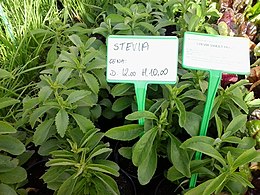




Asteraceae is an economically important family, providing products such as cooking oils, leaf vegetables like lettuce, sunflower seeds, artichokes, sweetening agents, coffee substitutes and herbal teas. Several genera are of horticultural importance, including pot marigold ( Calendula officinalis), coneflowers ( Echinacea), various daisies, fleabane, chrysanthemums, dahlias, zinnias, and heleniums.
Asteraceae are important in herbal medicine, including Grindelia, yarrow, and many others.[ citation needed]
Commercially important plants in Asteraceae include the food crops Lactuca sativa (lettuce), Cichorium (chicory), Cynara scolymus (globe artichoke), Helianthus annuus ( sunflower), Smallanthus sonchifolius (yacón), Carthamus tinctorius (safflower) and Helianthus tuberosus (Jerusalem artichoke).[ citation needed]




Plants are used as herbs and in herbal teas and other beverages. Chamomile, for example, comes from two different species: the annual Matricaria chamomilla (German chamomile) and the perennial Chamaemelum nobile (Roman chamomile). Calendula (known as pot marigold) is grown commercially for herbal teas and potpourri. Echinacea is used as a medicinal tea. The wormwood genus Artemisia includes absinthe (A. absinthium) and tarragon (A. dracunculus). Winter tarragon ( Tagetes lucida), is commonly grown and used as a tarragon substitute in climates where tarragon will not survive.[ citation needed]
Many members of the family are grown as ornamental plants for their flowers, and some are important ornamental crops for the cut flower industry. Some examples are Chrysanthemum, Gerbera, Calendula, Dendranthema, Argyranthemum, Dahlia, Tagetes, Zinnia, and many others. [29]

Many species of this family possess medicinal properties and are used as traditional antiparasitic medicine. [13]
Members of the family are also commonly featured in medical and phytochemical journals because the sesquiterpene lactone compounds contained within them are an important cause of allergic contact dermatitis. Allergy to these compounds is the leading cause of allergic contact dermatitis in florists in the US. [31] Pollen from ragweed Ambrosia is among the main causes of so-called hay fever in the United States. [32]
Asteraceae are also used for some industrial purposes. French Marigold ( Tagetes patula) is common in commercial poultry feeds and its oil is extracted for uses in cola and the cigarette industry. [29] The genera Chrysanthemum, Pulicaria, Tagetes, and Tanacetum contain species with useful insecticidal properties. [29] Parthenium argentatum (guayule) is a source of hypoallergenic latex. [29]
Plants that contain high concentrations of inulin include:
- Burdock (Arctium lappa)
- Chicory (Cichorium intybus)
- Coneflower ( Echinacea spp.)
- Dandelion (Taraxacum officinale)
- Elecampane (Inula helenium)
- Globe artichoke (Cynara scolymus, Cynara cardunculus var. scolymus)
- Jerusalem artichoke (Helianthus tuberosus)
- Leopard's bane ( Arnica montana)
- Mugwort root ( Artemisia vulgaris)
- Yacón (Smallanthus sonchifolius)

Several members of the family are copious nectar producers [29] and are useful for evaluating pollinator populations during their bloom.[ citation needed] Centaurea (knapweed), Helianthus annuus (domestic sunflower), and some species of Solidago (goldenrod) are major " honey plants" for beekeepers. Solidago produces relatively high protein pollen, which helps honey bees over winter. [33]
Culture
.......
- Rhymes and games
He loves me... he loves me not Taraxacum#Cultural importance

.......
- State flowers of the United States (or Flowers representing cities, countries, or whatever)
List of U.S. state and territory flowers
-
Maryland||
Black-eyed susan || Rudbeckia hirta ||
|| 1918 [37]
-
Mississippi ||
Tickseed (state wildflower) || Coreopsis ||
 ||1991
[38]
||1991
[38]
-
Oklahoma ||
Indian blanket (state wildflower) || Gaillardia pulchella ||
 || 1986
[41]
|| 1986
[41]
-
South Carolina ||
Goldenrod (state wildflower) || Solidago altissima ||
 || 2003
[42]
|| 2003
[42]
-
Tennessee ||
Tennessee purple coneflower (state wildflower 2) || Echinacea tennesseensis ||
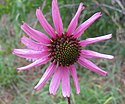 || 2012
[43]
|| 2012
[43]
Asters
.......
- Michaelmas
.......
Marigolds
.......
- Hinduism



.......
- Catholicism
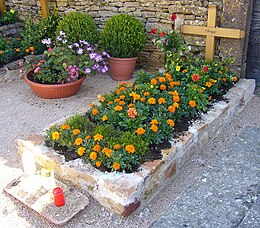


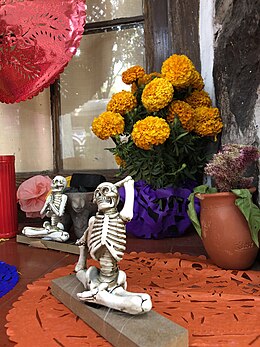
.......
References
- ^ a b c Barreda, Viviana D.; Palazzesi, Luis; Tellería, Maria C.; Olivero, Eduardo B.; Raine, J. Ian; Forest, Félix (2015). "Early evolution of the angiosperm clade Asteraceae in the Cretaceous of Antarctica". Proceedings of the National Academy of Sciences of the United States of America. 112 (35): 10989–10994. Bibcode: 2015PNAS..11210989B. doi: 10.1073/pnas.1423653112. PMC 4568267. PMID 26261324.
- ^ "Asteraceae Bercht. & J.Presl". Tropicos. Missouri Botanical Garden. Retrieved 14 July 2017.
- ^ a b "The Plant List: Compositae". The Plant List (www.theplantlist.org). Royal Botanic Gardens Kew and Missouri Botanic Garden. 2013. Retrieved 18 November 2016.
- ^ "Family: Asteraceae Bercht. & J. Presl, nom. cons". Germplasm Resources Information Network (GRIN) (www.ars-grin.gov). Beltsville, Maryland: USDA, ARS, National Genetic Resources Program, National Germplasm Resources Laboratory. Archived from the original on 17 September 2008. Retrieved 12 June 2008.
- ^ a b Hind, D.J.N. (2009). " Neotropical Asteraceae." In: Milliken, W., Klitgård, B. & Baracat, A. (2009 onwards). Neotropikey - Interactive key and information resources for flowering plants of the Neotropics. Royal Botanic Gardens, Kew. Retrieved 20 February 2021.
- ^ a b c d e Barkley, Theodore M.; Brouillet, Luc; Strother, John L. (6 November 2020). "Asteraceae Berchtold & J. Presl - Composite Family". Flora of North America (floranorthamerica.org). Retrieved 18 February 2021.
- ^ a b Kilian, Norbert; Gemeinholzer, Birgit; Lack, Hans Walter. "24. Cichorieae" (PDF). In Funk, V.A.; Susanna, A.; Stuessy, T.E.; Bayer, R.J. (eds.). Systematics, evolution and biogeography of Compositae. Vienna: International Association for Plant Taxonomy. Retrieved 20 February 2021.
- ^ Morhardt, Sia; Morhardt, Emil (2004). California desert flowers: an introductions to families, genera, and species. Berkeley, Los Angeles, and London: University of California Press. pp. 29–32. ISBN 978-0520240032.
- ^ McKenzie, R.J.; Samuel, J.; Muller, E.M.; Skinner, A.K.W.; Barker, N.P. (2005). "Morphology of cypselae in subtribe Arctotidinae (Compositae–Arctotideae) and its taxonomic implications". Annals of the Missouri Botanical Garden. 92 (4): 569–594. JSTOR 40035740. Retrieved 18 February 2021 – via ResearchGate.
- ^ a b c Judd, W.S.; Campbell, C.S.; Kellogg, E.A.; Stevens, P.F.; Donaghue, M.J. (2007). Plant Systematics: A Phylogenetic Approach (3rd ed.). Sunderland: Sinauer Associates. ISBN 978-0878934072.
- ^ Tomb, A. Spencer (May–June 1974). "Pollen morphology and detailed structure of family Compositae, tribe Cichorieae. I. Subtribe Stephanomeriinae". American Journal of Botany. 61 (5): 486–498. doi: 10.1002/j.1537-2197.1974.tb10788.x. JSTOR 2442020.
- ^ a b c d Stevens, Peter F. (2001). "Angiosperm Phylogeny Website: Asterales". Angiosperm Phylogeny Website.
- ^ a b Panda, Sujogya Kumar; Luyten, Walter (2018). "Antiparasitic activity in Asteraceae with special attention to ethnobotanical use by the tribes of Odisha, India". Parasite. 25: 10. doi: 10.1051/parasite/2018008. ISSN 1776-1042. PMC 5847338. PMID 29528842.
- ^ von Royen, Adriani (1740). Florae leydensis prodromus : exhibens plantas quae in Horto academico Lugduno-Batavo aluntur (in Latin). Lugduni Batavorum [Leiden]: Apud Samuelen Luchtmans academiae typographum. Retrieved 18 February 2021 – via Botanicus.
- ^ a b Panero, J.L.; Funk, V.A. (2002). "Toward a phylogenetic subfamilial classification for the Compositae (Asteraceae)". Proceedings of the Biological Society of Washington. 115: 909–922 – via Biodiversity Heritage Library.
- ^ a b Panéro, José L.; Freire, Susana E.; Ariza Espinar, Luis; Crozier, Bonnie S.; Barboza, Gloria E.; Cantero, Juan J. (2014). "Resolution of deep nodes yields an improved backbone phylogeny and a new basal lineage to study early evolution of Asteraceae". Molecular Phylogenetics and Evolution. 80 (1): 43–53. doi: 10.1016/j.ympev.2014.07.012. PMID 25083940 – via ResearchGate.
- ^ Fu, Zhi-Xi; Jiao, Bo-Han; Nie, Bao; Zhang, Guo-Jin; Gao, Tian-Gang (22 July 2016). "A comprehensive generic‐level phylogeny of the sunflower family: Implications for the systematics of Chinese Asteraceae". Journal of Systematics and Evolution. 54 (4): 416–437. doi: 10.1111/jse.12216. S2CID 89115861 – via ResearchGate.
- ^ Funk, Vicki A.; Fragman-Sapir, Ori (2009). "22. Gymnarrheneae (Gymnarrhenoideae)" (PDF). In V.A. Funk; A. Susanna; T. Stuessy; R. Bayer (eds.). Systematics, Evolution, and Biogeography of Compositae. Vienna: International Association for Plant Taxonomy. pp. 327–332. ISBN 978-3950175431.
- ^ a b Panero, Jose L.; Crozier, Bonnie S. (27 January 2012). "Asteraceae. Sunflowers, daisies". The Tree of Life Web Project (tolweb.org).
- ^ Gardocki, Mary E.; Zablocki, Heather; El-Keblawy, Ali; Freeman, D. Carl (2000). "Heterocarpy in Calendula micrantha (Asteraceae): the effects of competition and availability of water on the performance of offspring from different fruit morphs". Evolutionary Ecology Research. 2 (6): 701–718. Retrieved 16 February 2021 – via ResearchGate.
- ^ a b Merriam-Webster, Merriam-Webster's Unabridged Dictionary, Merriam-Webster.
- ^ "International Code of Nomenclature for algae, fungi, and plants – Article 18.5". iapt-taxon.org.
- ^ "Tansy ragwort". Washington State Noxious Weed Control Board (www.nwcb.wa.gov). Retrieved 21 January 2021.
- ^ "Common groundsel". Washington State Noxious Weed Control Board (www.nwcb.wa.gov). Retrieved 21 January 2021.
- ^ González-Castejón, Marta; Visioli, Francesco; Rodriguez-Casado, Arantxa (17 August 2012). "Diverse biological activities of dandelion". Nutrition Reviews. 70 (9): 534–547. doi: 10.1111/j.1753-4887.2012.00509.x. ISSN 0029-6643. PMID 22946853.
- ^ "Taraxacum officinale: dandelion". Invasive Plant Atlas of the United States (www.invasiveplantatlas.org). Retrieved 10 September 2012.
- ^ "Senecio angulatus (Cape ivy, Climbing groundsel, Creeping groundsel)". AUB Landscape Plant Database (landscapeplants.aub.edu.lb). Beirut, Lebanon: American University of Beirut. Retrieved 16 February 2021.
- ^ "Senecio angulatus - climbing groundsel". Brisbane City Council weed identification tool (weeds.brisbane.qld.gov.au). Brisbane, Queensland, Australia: Brisbane City Council. Retrieved 16 February 2021.
- ^ a b c d e f Singh, Rajendra; Singh, Garima; Tiwari, Ajeet; Patel, Shveta; Agrawal, Ruhi; Sharma, Akhilesh; Singh, B. (2015). "Diversity of host plants of aphids (Homoptera: Aphididae) infesting Asteraceae in India". International Journal of Zoological Investigations. 1 (2): 137–167. Retrieved 16 February 2021 – via ResearchGate.
- ^ Auld, B.A.; Meld, R.W. (1992). Weeds: an illustrated botanical guide to the weeds of Australia. Melbourne: Inkata Press. p. 264. ISBN 978-0909605377.
- ^ Odom, R.B.; James, W.D.; Berger, T.G. (2000). Andrews' Diseases of the Skin: Clinical Dermatology. W.B. Saunders Company. p. 1135. ISBN 978-0721658322.
- ^ Asthma and Allergy Foundation of America. "Ragweed Allergy". Archived from the original on 7 October 2007. Retrieved 10 November 2007.
-
^
"Five Plants to Help Pollinators". The Xerces Society. 2016. Retrieved 2 June 2020.
Goldenrods are among the most important late-season pollinator plants.
- ^ "State Wildflower". Florida Department of State. Retrieved 30 December 2019.
- ^ "Kansas State Flower: Sunflower Facts". Kansas Native Plant Society. Retrieved 30 December 2019.
- ^ "Kentucky State Symbols". Kentucky Department of Libraries and Archives. 30 March 2007. Archived from the original on 28 January 2011. Retrieved 2 July 2007.
- ^ "Fiscal and Policy Notes (HB 345)" (PDF). Department of Legislative Services - Maryland General Assembly. 2010. Archived from the original (PDF) on 7 June 2011. Retrieved 13 March 2010.
- ^ Guyton, John (2013). "Mississippi's Wildflowers are Coreopsis spp" (PDF). Mississippi Native Plants and Environmental Education. Vol. 31, no. 1. Mississippi Native Plant Society.
- ^ "State Symbols". Nebraska Secretary of State. 3 October 2019. Retrieved 30 December 2019.
- ^ https://www.leg.state.nv.us/Statutes/54th/Stats196704.html#Stats196704page702
- ^ https://www.okhistory.org/kids/symbols
- ^ "South Carolina Code of Laws, State Emblems, Pledge to the Flag, Official Observances". South Carolina General Assembly. Archived from the original on 30 June 2007. Retrieved 16 July 2007.
- ^ https://sos.tn.gov/sites/default/files/Pgs.%20599-627%20TN%20Symbols.pdf
Cite error: A
list-defined reference named "MDW" is not used in the content (see the
help page).
Cite error: A
list-defined reference named "Usher" is not used in the content (see the
help page).
External links
-
 Media related to
Eewilson/sandbox at Wikimedia Commons
Media related to
Eewilson/sandbox at Wikimedia Commons -
 Data related to
Eewilson/sandbox at Wikispecies
Data related to
Eewilson/sandbox at Wikispecies
- Asteraceae at the Angiosperm Phylogeny Website
- Compositae.org – Compositae Working Group (CWG) and Global Compositae Database (GCD)



